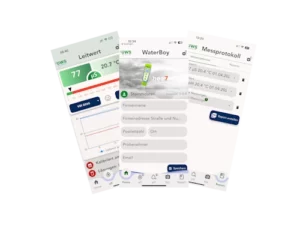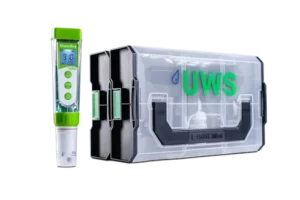Avoid sources of error: Correctly measuring, documenting and calibrating heating water
Small cause, big effect – why avoidable errors in heating water analysis often lead to corrosion, energy losses and warranty problems.
Heating water is not just water. It is a complex medium that must function smoothly in modern systems with sensitive materials, tight tolerances and high energy requirements. Even small deviations in water quality – whether in the pH value, conductivity or due to excessive oxygen input – can have serious consequences.
Standards such as the VDI 2035, ÖNORM H 5195-1 and SWKI BT 102-01 specify clear limit values and procedures. However, in practice, measurement errors, documentation gaps or procedural deviations can quickly creep in. The good news is that with a little know-how and digital support, these pitfalls can be avoided.
Common mistakes in heating water analysis – and how to avoid them
1. uncalibrated or incorrectly calibrated measuring devices
The problem:
A pH meter is only as good as its last calibration. Even small deviations lead to incorrect evaluations – with consequences for dosing, post-treatment or even guarantees.
This is how you do it right:
- Before each measurement, check when the last calibration was carried out.
- VDI 2035 recommends calibration intervals of max. 4 weeks with frequent use.
- The WaterBoy app automatically reminds you of upcoming calibrations – and guides you clearly through the 1-, 2- or 3-point calibration.
- Only use fresh, temperature-stabilized calibration solutions.
- After calibration, rinse the electrode thoroughly with heating water to remove any residue.
Practical tip: If you are unsure, it is better to calibrate too much than to work with incorrect values. A pH value of 9.4 instead of 8.5 is already critical for aluminum components.

WaterBoy App
With the help of the UWS WaterBoy app, measuring and determining the required parameters is child’s play. The free app is available for Android and iOS.To the product
2. incorrect or contaminated sample containers
The problem:
If heating water is taken from unsuitable containers such as used PET bottles or oil-smeared beakers, this falsifies the measurement results – especially for oxygen and pH value.
This is how you do it right:
- Only use oil-free and residue-free laboratory vessels or the beakers supplied in the WaterBoy case.
- No household dishes or used glass – even minimal residues affect the result.
- Rinse containers with demineralized water or heating water after each use.
3. wrong sampling – wrong place, wrong moment
The problem:
If the sample is taken at the wrong point (e.g. at the low point) or without first draining stagnant water, the measured values are unusable.
This is how you do it right:
- Always take the sample at a tapping point with a good flow, as close as possible to the return flow.
- Drain approx. 1-2 liters of stagnant water beforehand to avoid stagnant areas.
- Keep the temperature below 50 °C during sampling, especially when measuring oxygen.
Standard reference: VDI 2047 Sheet 3 describes a comparable procedure for sampling cooling water – also transferable to heating circuits.
4. oxygen input due to unsuitable extraction
The problem:
If the heating water is tapped openly or with too much air contact, the oxygen content increases – and with it the risk of corrosion.
This is how you do it right:
- Take the sample directly from the sample tap using a short, clear hose.
- Guide the hose into the measuring vessel in an S-shape so that as little of the water surface as possible is exposed to the air.
- No spraying, no recasting – measure directly!
Important: The target value according to VDI 2035 is <0.1 mg/l dissolved oxygen. Even a low air supply during extraction can significantly falsify this value.
5. incorrect or incomplete documentation
The problem:
Paperwork, Excel lists or handwritten notes – all of which are not audit-proof and often untraceable. In the event of a warranty claim or change of operator, important evidence is missing.
This is how you do it right:
- Use digital systems such as the WaterBoy app to save measured values directly on site at the customer’s premises – object-related and standard-compliant.
- Export all data as a PDF report and send it directly to the customer by e-mail if desired.
- Archiving takes place automatically in the app – no reworking necessary.
6. Contaminated or uncleaned measuring probe
The problem:
If the measuring probe is not thoroughly cleaned before or after the measurement, residues of calibration solutions, storage liquid or previous heating water can massively falsify the measurement results. Particularly critical: Residues of the highly concentrated storage solution or calibration liquids that affect the pH value.
How to do it right:
- Rinse the probe and electrode thoroughly with distilled water before and after each measurement – preferably with light pressure from a dosing bottle.
- When calibrating, make sure that no residues of the old buffer solution remain. Ideally, rinse with distilled water between the calibration points.
- After the last measurement, also clean thoroughly before returning the probe to the storage solution.
- Drying? Only dab carefully – never rub! The sensitive glass membrane must not be damaged.
Important: Cleaning is not a minor matter – it is a prerequisite for repeatable, precise and standard-compliant measured values.
Bonus tip: Know the right values – and interpret them correctly
Sometimes the error is not in the measurement, but in the incorrect evaluation of the result. Here is a brief overview of typical target values according to VDI 2035:
| Parameters | Target value |
| Electrical conductivity | <100 µS/cm (with low-salt operation) |
| pH value | 8.2 – 10.0 (max. 9.0 for aluminum) |
| Total hardness | <0.3 °dH (depending on system size) |
| Oxygen | <0.1 mg/l |
Robust measurement technology on the move – with a system
The UWS WaterBoy has everything you need for standard-compliant measurements:
- Combination device for pH and conductivity
- L-BOXX case for mobile use
- Magnetite stick for visual control
- Accessories for total hardness measurement
- Replaceable electrode for low operating costs
- Free app for iOS and Android

WaterBoy measuring case
The UWS WaterBoy measuring case contains everything the HVAC specialist needs to measure data in accordance with the VDI 2035, ÖNORM H 5195-1 and SWKI BT 102-01 standards in two L-BOXXES.To the product
Conclusion: clean measurement saves in the long term
Errors in heating water analysis can be avoided – with the right know-how, clean sampling and digitally supported measurement technology. For HVAC contractors, this means
- Safe systems
- Legally compliant documentation
- More efficient maintenance
- Better customer communication
And last but not least: Less hassle afterwards.



